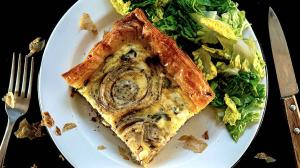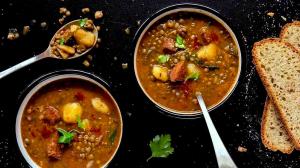ONIONS are not just something to be added to dishes as a flavoring. They can be the star of the dish because they’re flavor bombs, especially after partly roasting.
Just as a PIE CRUST is not just a bland vessel to contain the pie fillings because it too can make the dish memorable, through its exceptional (and hopefully not soggy) crispy and flaky texture !
This preparation could be called a quiche but when pies are made with filo pastry sheets, they’re often called pitas or bureks and usually include eggs but no cream and some type of cheese, usually being feta. Quiches, on the other hand, always include many eggs and cream and grated cheeses.
There are similarities as well as differences between the two types of preparations but were just going to call this dish a “PIE” because we’re simple folks, or at least trying to be.
The ingredient ratios and instructions for this creamy and crispy pie are simple to remember.
The filling is composed of half partly roasted, thus softened and partly dehydrated onions and half heavy cream, cream cheese, feta cheese and eggs. To go even further, the liquid filling mixture (excluding the onions) is two-thirds cream and cheeses and one-third eggs.
The pie crust is one third of the total weight of the pie filling and composed of approximately two-thirds filo sheets and one-third melted butter and olive oil.
All in all, you’ll have a pie that is three-quarters filling and one-quarter crust.
It’s true that filo isn’t easy to work with, because it tends to dry out quickly, especially when you need to fold it or stuff it or wrap it around a filling but this pie is open-faced with filo only on the bottom and the sides and layering the butter or oil-drizzled or brushed sheets is rapid, solidifies them, avoids them from drying out and makes them easy to press and shape into a baking dish. Simply cut off the excess if there is too much of an overlap and try not to forget to snip the overhanging filo sheets where you except to slice the pie after baking it, to avoid cracking the exposed drier baked filo when you’ll slice up the servings.
I used a rectangular enameled baking dish measuring 22 cm x 28 cm x 3 cm high, that is appropriately smaller than the rectangular filo sheets, measuring approximately 30 cm x 40 cm each. Filo is best baked in enameled or glass dishes but other non-stick type of baking dishes are good too.
And to end this long-winded explanatory introduction, I sliced the onions thickly and kept the onion rings intact, not only because of the visual impact but also for a textural contrast to the surrounding creamy filling and crunchy and crispy outer crust.
That’s my story, so get baking and/or experimenting and have a nice weekend … :)
p.s.: I realize that with lockdown and curfews, it might be difficult to get some of the more exotic ingredients like feta cheese and filo dough sheets so feel free to replace the filo with puff-pastry dough preferably or a regular shortcrust pastry dough and perhaps some cottage cheese mixed with soft and mild goat cheese and some extra added salt could replace the feta cheese.













